Ohm’s Law Flow Of Free Electrons In Metallic Conductors
Celestron: The attractive force of the nucleus on the electrons of the outermost orbit is negligibly small in atoms of metals like silver, copper, aluminum etc.
So, these electrons can be detached very easily from the atom. For Example, at room temperature, these electrons can be detached very easily from the atoms.
These electrons are called free electrons. They are called ‘free’ because they can move freely within the lattice sites of the metals. Of course, they cannot move out of the atom on their own.
Drift: If a potential difference is applied between the two ends of a piece of metal, the free electrons of die metal are attracted towards die positive potential. So the motion is unidirectional.
This unidirectional motion from lower potential to higher potential is called die drift of the free electrons. Due to this drift, a current flows through die metal; diese-free electrons are then called die charge carriers.
Metals contain a large number of free electrons. So, current flows through them. Hence, metals are generally good conductors of electricity.
On the other hand, at ordinary temperatures, there are no free electrons in wood, paper, rubber, etc.; so they are insulators.
Origin of resistance:
The conductivity of metals is due to the drift of free electrons but no such drift occurs to atoms or ions which are comparatively heavy.
They vibrate about their equilibrium positions. Free electrons, in the course of their motion, collide with the vibrating atoms and ions and are retarded.
Read and Learn More Class 12 Physics Notes
So their drift is hindered. This gives rise to the resistance. Widi increase of temperature vibrations of the ions increases. So the free electrons encounter greater resistance during their drift i.e., the resistance of the conductors increases.
On the other hand, when the temperature reaches absolute zero, the ions come almost to a standstill.
Then the free electrons can move through the empty space surrounding the ions almost without any resistance. Under this condition, some metals exhibit the property of superconductivity.
Other than metals, gas under low pressure, electrolytes, and semiconductors also conduct current. The charge carriers in these cases are different in nature. So electric conductivity for these substances cannot be explained with the free electron theory
Drift Velocity of Free Electrons and Electric Current Density:
Drift velocity of free electrons: The average velocity with which the free electrons move in a current-carrying metallic wire is called the drift velocity of the free electrons.
Calculation: Consider a metallic wire,
n = number of electrons per unit volume = number density of free electrons
e = charge of an electron = 1.6 x 10-19C = 4.8 x 10-1 esu of charge
A = cross-sectional area of the wire
I = electric current through the wire
vd = drift velocity of the free electrons
The number of free electrons passing through a definite cross-section of die wire per second is confined within a cylinder of length vd.
The volume of that cylinder = Avd
Number of electrons in die cylinder = nAvd
So, the amount of electric charge in die cylinder = neAvd i.e., neAvd is the amount of charge diat crosses any section of the wire per second. By definition, electric current is the die rate of flow of electric charge across any section of a wire.

∴ \(I=n e A v_d \quad \text { or, } v_d=\frac{I}{n e A}\)…(1)
Again, the electric current flowing through unit cross-sectional area is called electric current density, expressed as
⇒ \(j=\frac{I}{A}=n e v_d\)…(2)
It is a vector quantity.
Definition: The electric current per cross-sectional area at a given point in space is termed as electric current density. It is directed along the motion of the charges.
The velocity of electric current: The velocity with which an electric field propagates through a conductor is called the velocity of electric current. This is also the velocity of propagation of electrical energy.
We intuitively know that this velocity is very high. If a switch is on in a power generating station, almost instantaneously a large area is flooded with light. Actually, the die velocity of electric current is equal to the velocity of light i.e., 186000 m.s-1 or 300000 km s-1.
Comparison Of the two velocities: Remember that electric current flows due to the drift of die-free electrons.
But drift velocity and the velocity of electric current are vastly different ideas. Suppose, for a wire, A = 1 mm2 = 10-6 m2, n = 5 x 1028 m-3 and I = 1 A.
So from equation (1), die drift velocity \(v_d=\frac{1}{8000} \mathrm{~m} \cdot \mathrm{s}^{-1}=\frac{1}{80} \cdot \mathrm{cm} \cdot \mathrm{s}^{-1}\) i.e.,- the electrons move through a distance of only 1cm 80 s.
This shows, how negligibly small the drift velocity is compared with the velocity of electric current.
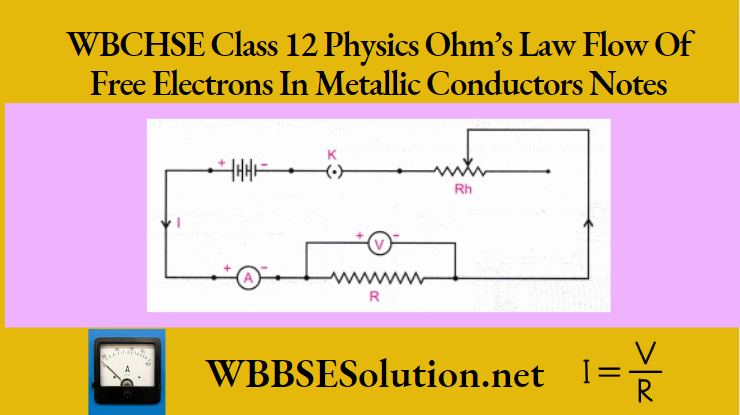
Mobility of Free Electrons:
Equilibrium of drift velocity: Suppose a potential difference of V is applied at the two ends of a homogeneous conductor of length,l. The magnitude of the uniform electric field produced inside the conductor is,
E = \(\frac{V}{l}\)….(1)
So, the force acting on a free electron inside the conductor,
⇒ \(e E=\frac{e V}{l}\)….(3)
Acceleration of a free electron = \(\frac{eV}{ml}\); (where m is the mass of the electron = 9.1 x 10-31 kg)
Due to this acceleration, the velocity of the electron will continuously increase. But practically does not happen. The motion of ‘ the electron is thwarted by its collision with the atoms and the ions inside the conductor. If this opposing force is considered to be equivalent to viscous force then the force acting against the. motion of the electron inside the metallic conductor is proportional to the velocity of the electron i.e., opposing force =kv [v = velocity of the electron; k = constant].
This opposing force increases with the increase of the velocity of the electron. At one time this force will be equal to the force due ‘ to the electric field. Since these two forces are- opposite to each other the resultant force becomes zero. Then the electron has no acceleration and it moves with uniform velofcitÿ inside the ’metallic conductor. This uniform velocity of the electron is the drift velocity vd of the free electrons. So the condition of equilibrium is
eE = kvd
or, \(v_d=\frac{e E}{k}=\mu E\)…..(3)
This constant \(\mu\left(=\frac{e}{k} \text { or } \frac{v_d}{E}\right)\) is called the mobility of the free electron. Clearly, if E = 1 then μ = vd.
Definition: Mobility of a free electron is the uniform drift velocity attained by it due to the application of a unit uniform electric field inside the metallic conductor.
Unit of μ: \(\text { As } \mu=\frac{v_d}{E}\)
So, unit of \(\mu=\frac{\text { unit of } v_d}{\text { unit of } E}=\frac{\mathrm{m} \cdot \mathrm{s}^{-1}}{\mathrm{~V} \cdot \mathrm{m}^{-1}}=\mathrm{m}^2 \cdot \mathrm{V}^{-1} \cdot \mathrm{s}^{-1}\)
Drift of Free Electrons and Ohm’s Law:
We have, \(v_d=\frac{I}{n e A}\)
But according to equations (1) and (3)
⇒ \(v_d=\frac{e E}{k}=\frac{e V}{k l}\)
So, \(\frac{e V}{k l}=\frac{I}{n e A}\)
So, \(∵ =\frac{k}{n e^2} \cdot \frac{l}{A} \cdot I\)…(1)
For a fixed conductor l sand A are constants. So V ∝ I; this is Ohm’s law.
If p is the resistivity of a metal, its resistance \(R=\rho \frac{l}{A}\)
So, \(V=R I=\rho \frac{l}{A} \cdot I\)….(2)
Comparing equations (1) and (2) we get,
resistivity, \(\rho=\frac{k}{n e^2}\)
i.e., conductivity of the metal, \(\sigma=\frac{1}{\rho}=\frac{n e^2}{k}\)
So, the conductivity of a metal depends on the number density of free electrons. Since the value of n differs from metal to metal, conductivity (i.e., resistivity) also differs from metal to metal.
Vector form Of Ohm’s low:
Let us consider a conductor of length =l, cross-sectional area =A, resistivity of the material = \(\rho\)
Then the resistance of the conductor,
⇒ \(R=\rho \cdot \frac{l}{A}=\frac{l}{\sigma A}\left[\sigma=\text { conductivity }=\frac{1}{\rho}\right]\)
If the potential difference between the two ends of the conductor be V, then the electric field generated,
⇒ \(E=\frac{V}{l} \text { i.e., } V=E l\)
On the other hand, if the current in the conductor is I, then current density, \(j=\frac{I}{A} \text { i.e., } I=j A\)
Following Ohm’s law,
V = IR
or, \(E l=j A \cdot \frac{l}{\sigma A}\)
or, E = \(E=\frac{1}{\sigma} \cdot j\)
or, j = \(\rho\)E
Here j and E are vectors.
So, \(\vec{j}=\sigma \vec{E}\) – this equation is the vector form of Ohm’s law.
Electric Current and Ohm’s Law Flow Of Free Electrons In Metallic Conductors Numerical Examples
Example 1. A 100 V battery has an internal resistance 3Ω. What is the reading of a voltmeter having resistance 20011, when placed across the terminals of the battery? What should be the minimum value of the voltmeter resistance so that the error in finding the emf of the battery may not be more than 1%?
Solution:
Main current, \(I=\frac{E}{R+r}=\frac{100}{200+3}\)
= \(\frac{100}{203} \mathrm{~A}\)
So, lost volt = \(I r=\frac{100}{203} \times 3\)
= \(\frac{300}{203}=1.48 \mathrm{~V}\)
Therefore, the reading of the voltmeter
V = E-Ir
= 100 – 1.48
= 98.52 V
In the second case, error = 1% = \(\frac{1}{100}\)
Reading of the voltmeter,
V = E – \(\frac{E}{100}\)
= 100-1
= 99V
So, lost volt =100-99 = IV
i.e.,\(I r=1 \quad \text { or, } I=\frac{1}{r}=\frac{1}{3} \mathrm{~A}\)
This current passes through the voltmeter. So resistance of the
voltmeter
⇒ \(\frac{V}{I}=\frac{99}{\frac{1}{3}}=297 \Omega\)
Example 2. A wire of resistance 10Ω is used to form a circular ring of circumference 10 cm. If two current-carrying conductors are connected at any two points, the subcircuit so formed has a resistance of 1Ω. Find the positions of the two points.
Solution:
Current carrying conductors are connected at the two points A and B of the circular ring. According to the question,
R1 + R2 = 10Ω….(1)
The two parts having resistances Rx and R2 form a parallel
combination at A and B whose equivalent resistance is 1Ω.
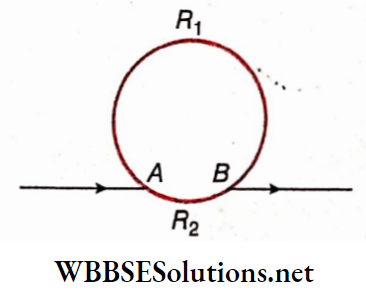
So, \(\frac{R_1 R_2}{R_1+R_2}=1 \text { or, } \frac{R_1 R_2}{10}=1 \text { or, } R_2=\frac{10}{R_1}\)
Substituting this value of R2 in equation (1) we have,
⇒ \(R_1+\frac{10}{R_1}=10\)
or, \(R_1^2-10 R_1+10=0\)
or, \(R_1=\frac{10 \pm \sqrt{10^2-4 \cdot 1 \cdot 10}}{2}=5 \pm \sqrt{15}=5 \pm 3.873\)
So, R1 = 8.873Ω (or 1.127Ω)
and R2 = (10 – R1)
= 1.127Ω (or 8.873Ω)
Since the resistance of the wire of length, 10 cm is 10Ω, the resistance of the wire of length 1 cm is 1Ω.
Therefore, the lengths of the two portions of the wire having resistances R1 and R2 are 8.873 cm and 1.127 cm.
Example 3. 12 cells each having the same emf are connected in series and are kept in a closed box. Some of the cells Reading of the voltmeter, are wrongly connected. This battery is connected in series with an ammeter and two other similar cells. The current is 3 A when the two cells aid the battery and is 2 A when the cells and the battery oppose each other. How many cells in the battery are wrong-connected?
Solution:
If n number of cells are wrongly connected, then the number of cells correctly connected in the battery =12-n; emf of each cell = E.
∴ Emf of the battery =(12-n)E-nE
= (12-2n)E
Again, the emf of the additional two cells = 2E.
Let R be the resistance of the whole circuit.
In the first case,
⇒ \(3=\frac{(12-2 n) E+2 E}{R}\)
or, \(\frac{3}{14-2 n}=\frac{E}{R}\)
In the second case,
⇒ \(2=\frac{(12-2 n) E-2 E}{R} \quad\)
or, \(\frac{2}{10-2 n}=\frac{E}{R}\)
∴ \(\frac{3}{14-2 n}=\frac{2}{10-2 n}\)
or, 28-4n = 30-6n
or, 2n = 2
or, n = 1
So, only one cell was wrongly connected.
Example 4. A cell of emf 1,4 V mid Internal resistance 2Ω Is connected In scries with a resistance of 100Ω and an ammeter. The resistance of the ammeter Is \(\frac{4}{3}\)Ω. To measure the potential difference between the two ends of the resistance a voltmeter is connected.
- Draw the circuit
- If the reading of the ammeter is 0.02 A, what Is the resistance of the voltmeter?
- If the reading of the voltmeter is 1.10 V, what will be its error?
Solution:
1. the circuit diagram
2. Lost volt of the cell = Ir = 0.02 x 2
= 0.04V
The potential difference between the two ends of the ammeter
⇒ \(0.02 \times \frac{4}{3}=\frac{0.08}{3} \mathrm{~V}\)
So, \(V_{C D}=1.4-0.04-\frac{0.08}{3}\)
= \(\frac{4.2-0.12-0.08}{3}\)
= \(\frac{4}{3} V\)
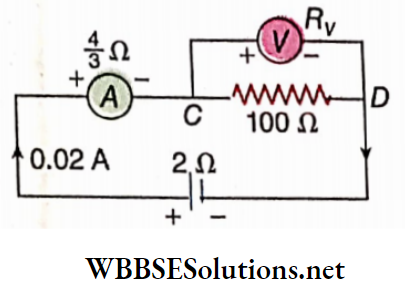
Therefore, current through 100Ω resistance
⇒ \(\frac{V_{C D}}{100}=\frac{4}{300} \mathrm{~A}\)
So, current through the voltmeter
⇒ \(0.02-\frac{4}{300}=\frac{2}{300} \mathrm{~A}\)
Therefore, the resistance of the voltmeter
⇒ \(\frac{V_{C D}}{\frac{2}{300}}=\frac{4}{3} \times \frac{300}{2}=200 \Omega\)
3. Voltmeter should record \(V_{C D}=\frac{4}{3}=1.33 \mathrm{~V}\)
∴ Error in the reading of the voltmeter
= 1.33 – 1.10
= 0.23 V
Example 5. What is the equivalent resistance between the two points A and B?
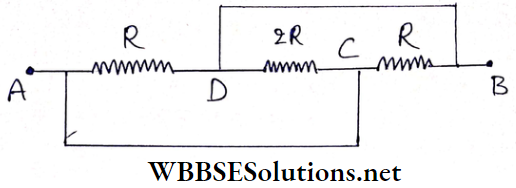
Solution:
The two points A and C are connected by connecting wires having no resistance. So their potentials are equal, i.e., the two points A and C are identical. Similarly, the two points B and D are Identical. So the circuit is the equivalent circuit.
Therefore, If r be the equivalent resistance between the two points A and B, then
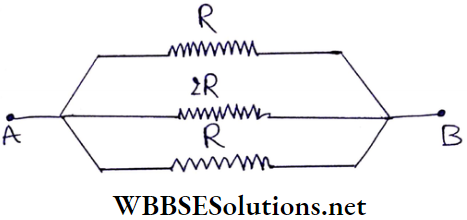
⇒ \(\frac{1}{r}=\frac{1}{R}+\frac{1}{2 R}+\frac{1}{R}=\frac{5}{2 R}\)
or, r = \(\frac{2R}{5}\)
= 0.4R
Example 6. The cmf of battery 1 is 1.8 V and internal resistance is \(\frac{2}{3}\)Ω. Calculate the current through the 3Ω resistance. What is the amount of dissipated energy in the whole circuit?
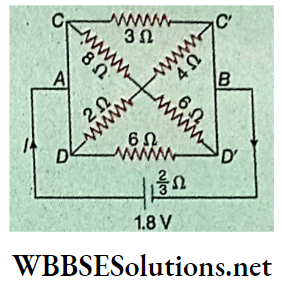
Solution:
The potentials of the two points C and D are equal to that of the point A. Again, the potential of the two points C’ and D’ are equal to that of the point B. So the circuit is the equivalent circuit of the resistance of the middle branch between A and B is
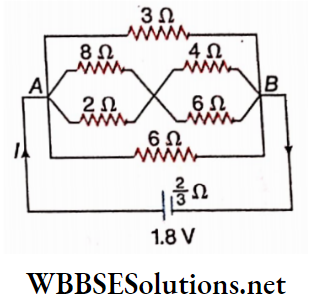
⇒ \(R_1=\frac{8 \times 2}{8+2}+\frac{4 \times 6}{4+6}=\frac{16}{10}+\frac{24}{10}=4 \Omega\)
Now if the equivalent resistance of 3Ω, R1 and 6Ω be R, then,
⇒ \(\frac{1}{R}=\frac{1}{3}+\frac{1}{R_1}+\frac{1}{6}\)
= \(\frac{1}{3}+\frac{1}{4}+\frac{1}{6}\)
= \(\frac{9}{12}\)
= \(\frac{3}{4}\)
or, R = \(\frac{4}{3}\)Ω
∴ Main current,
⇒ \(I=\frac{1.8}{\frac{4}{3}+\frac{2}{3}}=\frac{1.8}{2}=0.9 \mathrm{~A}\)
∴ \(V_{A B}=I R=0.9 \times \frac{4}{3}=1.2 \mathrm{~V}\)
So the current through the resistance of 3Ω
⇒ \(\frac{V_{A B}}{3}=\frac{1.2}{3}=0.4 \mathrm{~A}\)
The amount of dissipated energy in the whole circuit = emf of the battery x main current
[See the chapter ‘Electrical Energy and Power’]
= 1.8 x 0.9
= 1.62 W
Example 7. An infinite ladder network of resistances is constructed with 1Ω and 2Ω resistances as shown. 1.36. The 6V battery’ between A and B has a negligible internal resistance,
- Show that the effective resistance between A and B is 2Ω.
- What is the current that passes through the 2Ω resistance nearest to the battery?
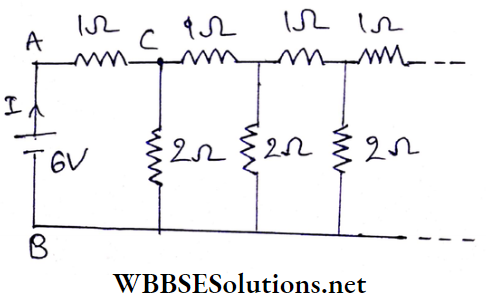
Solution:
Suppose, effective resistance between A and B = R. From this it is clear that on the right side of CD, the infinite network is equivalent to that on the right side of AB, because deleting one chain does not affect the equivalent resistance R. So, the circuit is the equivalent circuit.
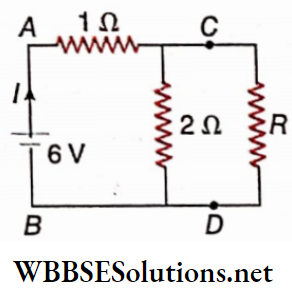
1. Effective resistance between A and B is
⇒ \(R=1+\frac{2 R}{2+R} \text { or, } R=\frac{2+3 R}{2+R}\)
or, R²-R-2 = 0
or, (R + 1)(R – 2) = 0
Obviously, R ≠ -1
Hence, R = 2Ω
2. Main current, \(I=\frac{6}{R}=\frac{6}{2}=3 \mathrm{~A}\)
∴ VAC = I x 1
= 3 x l
= 3V
∴ VCD = 6-3
= 3V
So, current through the 2Ω resistance nearest to the battery
⇒ \(\frac{V_{C D}}{2}=\frac{3}{2}=1.5 \mathrm{~A}\)
Example 8. ln the circle shown in the calculate the direct current (dc) through the 2Ω resistance. The Internal resistance of the battery is negligible and C = 0.2μF
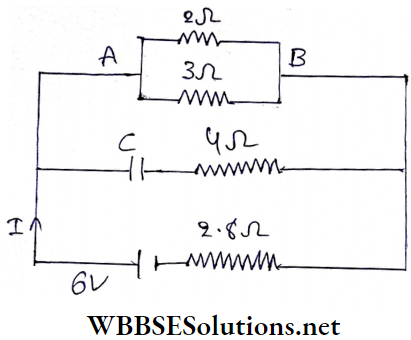
Solution:
Direct current cannot pass through any capacitor.
So, no current flows through the 4Ω resistance.
Now, equivalent resistance between A and B
⇒ \(=\frac{2 \times 3}{2+3}=\frac{6}{5}=1.2 \mathrm{~A}\)
So, main current, \(I=\frac{6}{1.2+2.8} \cdot=\frac{6}{4}=1.5\)A
Since no current passes through a capacitor In the steady state, tire branch containing C and 4Ω has been treated as deleted.
∴ VAB = I x 1.2
= 1.5 x 1.2
= l.8 V
∴ Current through 2Ω resistance = \(\frac{V_{A B}}{2}=\frac{1.8}{2}=0.9 \mathrm{~A}\)
Example 9. Three resistances A, B, and C are connected in such a way that their combined equivalent resistance is equal to that of B. If A and B arc 10Ω and 30Ω respectively, find the three possible values of C and draw the corresponding circuits.
Solution:
In this case, there are only three possible arrangements. If the three resistances are arranged in any other alternative way the equivalent resistance will be greater than B or less than B.
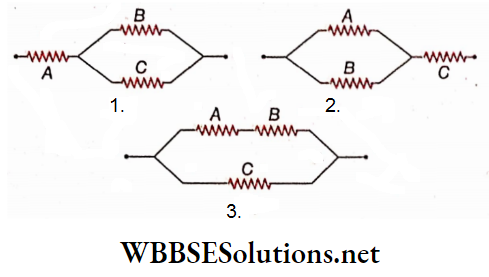
In each arrangement, the equivalent resistance is equal to B (given).
So, in ±e arrangement (a),
⇒ \(A+\frac{B C}{B+C}=B \quad \text { or, } 10+\frac{30 C}{30+C}=30\)
or, 30C = 600 + 20C
or, 10C = 600
or, C = 60 11
In the arrangement (b),
⇒ \(\frac{A B}{A+B}+C=B \quad \text { or, } \frac{10 \times 30}{10+30}+C=30\)
or, \(C=30-\frac{30}{4}=30-7.5=22.5 \Omega\)
In the arrangement (c),
⇒ \(\frac{(A+B) C}{(A+B)+C}=B \quad \text { or, } \frac{(10+30) \times C}{(10+30)+C}=30\)
or, \(\frac{40 C}{40+C}=30\)
or, 40C = 1200 + 30C
or, 10C = 1200
or, C = 120Ω
Example 10. Two cells, one of emf 1.4 V and internal resistance 0.6Ω, the other of emf 2.5 V and internal resistance 0.3Ω are connected in parallel and the combination is connected in series with an external resistance of 4Ω. What is the current through this resistance?
Solution:
Suppose the potential difference between
A and B, VA-VB = V
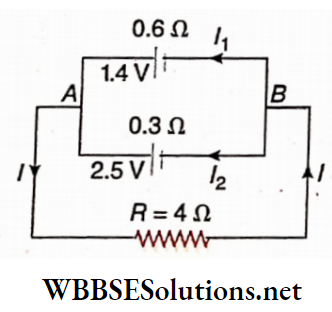
So, for the first cell \(V=E_1-I_1 r_1 \text { or, } I_1=\frac{E_1-V}{r_1}\)
Similarly, for the second cell \(I_2=\frac{E_2-V}{r_2}\)
For the resistance R of the external circuit I = \(\frac{V}{R}\)
Clearly, \(I=I_1+I_2 \quad \text { or, } \frac{V}{R}=\frac{E_1-V}{r_1}+\frac{E_2-V}{r_2}\)
or, \(V\left(\frac{1}{R}+\frac{1}{r_1}+\frac{1}{r_2}\right)=\frac{E_1}{r_1}+\frac{E_2}{r_2}\)
or, \(V\left(\frac{1}{4}+\frac{1}{0.6}+\frac{1}{0.3}\right)=\frac{1.4}{0.6}+\frac{2.5}{0.3}\)
or,V (0.25 + 1.66 + 3.33) = 2.33 + 8.33
or, \(V \cdot=\frac{10.66}{5.24} \mathrm{~V}\)
∴ Current through R,
⇒ \(I=\frac{V}{R}=\frac{10.66}{5.24 \times 4}=0.508 \mathrm{~A}\)
Example 11. In the circuit, each battery is 5 V and has an internal resistance of 0.2Ω the voltmeter is an ideal one, what is its reading?
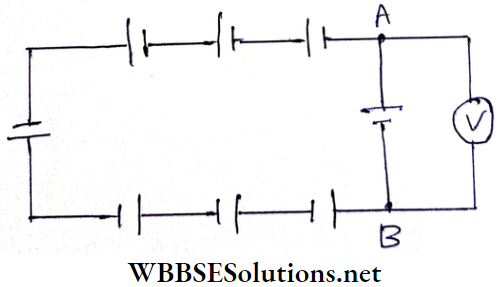
Solution:
The resistance of an ideal voltmeter is infinite. So the magnitude of current passing through it is negligible. It only gives the reading of the potential difference between A and B. Herein the circuit of 8 batteries there is no external resistance, only internal resistances of the batteries exist.
So current in the circuit, \(I=\frac{8 E}{8 r}=\frac{E}{r}\)
∴ Lost volts the battery connected between A and B
⇒ \(=I r=\frac{E}{r} \cdot r=E\)
∴ The potential difference between A and B,
V = E-Ir
= E-E
= 0
So the voltmeter gives zero reading.
Example 12. A few storage cells in series are to be charged from a 200 V dc supply. The emf of each cell is 2.5 V, internal resistance 0.1Ω and the charging current is 8 A. In this arrangement how many cells can be charged and what extra resistance is required to be connected in the circuit?
Solution:
Suppose, the maximum no. of cells =x and extra resistance = R.
Here, E = 2.5 V, r = 0.1Ω, I = 8 A
∴ By the condition, Ex + Ir . x + IR = 200
or, (2.5 + 8 x 0.1)x + 8R = 200
or, 3.3x + 8R = 200
Now, if we divide 200 by 3.3 the quotient is 60 and the remainder is 2.
So, the required number of cells = 60, and 2 V is the potential difference across the extra resistance R.
i.e., 8R = 2 or, R = \(\frac{2}{8}\) = 0.25Ω
Example 13. A copper wire of crow sectional area 1 mm2 carries a current of 0.21 A. Find the drift velocity of free electrons. Given: density of free electrons in copper = 8.4 x 1028 m-3 and electronic charge e = 1.6 x 10-19 C.
Solution:
Current in copper wire I = 0.21 A, electronic charge
e = 1.6 x 10-19C, density of free electrons in copper
n = 8.4 x 1028 m-3, cross-sectional area of copper wire
A = 1 mm2 = 10-6 m2
∴ Drift velocity
⇒ \(v_d=\frac{I}{n e A}=\frac{0.21}{\left(8.4 \times 10^{28}\right) \times\left(1.6 \times 10^{-19}\right) \times 10^{-6}}\)
= 1.56 m.s-1
Example 14. A copper wire of diameter \(\frac{2}{3 \sqrt{\pi}} \mathrm{mm}\) is carrying a current of 1 amp. Calculate the number of free electrons that flow past any cross-section of the wire peT sec. Also, find the average speed with which free electrons are flowing in the copper wire assuming that there Is one free electron per atom of copper. Number of atoms per cm3 of copper = 9 x 1022, electronic charge = 1.6 x 10-19 coulomb.
Solution:
Diameter, \(d=\frac{2}{3 \sqrt{\pi}} \mathrm{mm}=\frac{2}{3 \sqrt{\pi}} \times 10^{-3} \mathrm{~m}\)
Area of cross-section
⇒ \(A=\frac{1}{4} \pi d^2=\frac{1}{4} \times \pi \times \frac{4}{9 \pi} \times 10^{-6} \mathrm{~m}^2=\frac{1}{9} \times 10^{-6} \mathrm{~m}\)
The number density of free electrons (n)
= number of copper atoms in unit volume
= 9 x 1022 cm-3
= 9 x 1028 m-3
The average speed of free electrons through the copper wire,
⇒ \(v=\frac{I}{n e A}=\frac{1}{\left(9 \times 10^{28}\right) \times\left(1.6 \times 10^{-19}\right) \times\left(\frac{1}{9} \times 10^{-6}\right)}\)
= 6.25 x 10-4 m.s-1
Number of free electrons flowing past any cross-section of the wire per unit time
⇒ \(n A v=\frac{I}{e}=\frac{1}{1.6 \times 10^{-19}}=6.25 \times 10^{18} \mathrm{~s}^{-1}\)
Example 15.
- Estimate the average drift speed of conduction electrons in a copper wire of cross-sectional area 1 x 10-7 m2 carrying a current of 1.5 A. Assume that each copper atom contributes one conduction electron. The density of copper is 9 x 103 kg.m3, and its atomic mass Is 63.5 u.
- Compare the drift speed obtained above With
- Thermal speed of electrons carrying the current at room temperature
- Speed of propagation of electricity Held along the conductor which causes the drift motion. Avogadro’s number =6.0 x 1025 per kg atom. Boltzmann constant, k = 1.38 X 10-23 J.K’1, mass of electron =9.1 x 1031 kg,
Solution:
1. We know drift velocity,
⇒ \(v_d=\frac{I}{n e A}\)…(1)
Here, 7= 1.5A,e = 1.6 x 10-19 C, A = 1 x 10-7m2, and n = number of electrons per unit volume.
Now, the number of atoms per unit volume of copper,
⇒ \(n^{\prime}=\frac{N}{M} \rho=\frac{6 \times 10^{26} \times 9 \times 10^3}{63.5}=8.5 \times 10^{28} \mathrm{~m}^{-3}\)
∴ One atom of copper contributes one conduction electron, therefore number density of electrons
n = n’ = 8.5 x 1028 m-3
Using the values of n, e, and A in equation (1), we get
⇒ \(v_d=\frac{1.5}{8.5 \times 10^{28} \times 1.6 \times 10^{-19} \times 1 \times 10^{-7}}\)
=1.1 x 10-3 m.s-1
2.
1. Thermal kinetic energy of electrons at room temperature T is given by,
⇒ \(\frac{1}{2} m v^2=\frac{3}{2} k T\)
∴ Thermal speed of electrons,
⇒ \(v=\sqrt{\frac{3 k T}{m}}\)
Here, k = 1.38 x 10-23 J.K-1; T = 273 + 27 = 300 K;
m = 9.1 x 10-31 kg.
∴ \(v=\sqrt{\frac{3 \times 1.38 \times 10^{-23} \times 300}{9.1 \times 10^{-31}}}=1.17 \times 10^5 \mathrm{~m} \cdot \mathrm{s}^{-1}\)
⇒ \(\frac{v_d}{v}=\frac{1.1 \times 10^{-3}}{1.17 \times 10^5}=0.9 \times 10^{-8} \approx 10^{-8}\)
2. The electric field propagates with the speed of the electromagnetic wave (c = 3 x 108 m.s_1) through the conductor.
∴ \(\frac{v_d}{c}=\frac{1.1 \times 10^{-3}}{3 \times 10^8}=3.6 \times 10^{-12}\)
Example 16. When an Iron wire of diameter 1 cm is copper plated uniformly, the resistance of iron reduces to \(\frac{1}{3}\) of its original value. Calculate the thickness of copper plating. The resistivities of copper and iron are 1.8 x 10-6Ω. cm and 1.98 x 10-1.cm respectively.
Solution:
Let the resistance of iron wire be r and that of copper plating x.
As they are in parallel, so equivalent resistance,
⇒ \(R_{\mathrm{eq}}=\frac{r x}{r+x}\)
∴ \(\frac{r x}{r+x}=\frac{r}{3} \quad \text { or, } 3 r x=r^2+r x \quad \text { or, } 2 r x=r^2\)
∴ x = \(\frac{r}{2}\)
Now, \(r=\rho \frac{l}{A}=\frac{1.98 \times 10^{-5} \times l}{\pi(0.5)^2}\)
Similarly, \(x=\frac{1.8 \times 10^{-6} \times l}{2 \pi(0.5) d}\)
Solving for r and x, it is observed that d = 0.045 cm (approx.)
Example 17. In an aluminum (Al) bar of square cross-section, a J square hole is drilled and is filled with iron (Fe). The electrical resistivities of Al and Fe are 2.7 x 10-8Ω.m and 10 x 10-8Ω.m respectively. Calculate the electrical resistance between the two faces P and Q of the composite bar
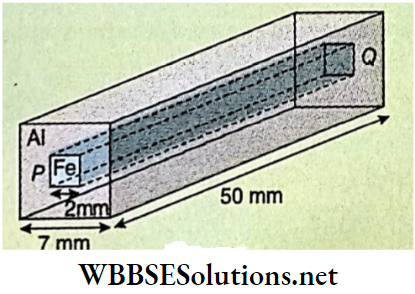
Solution:
The barswill bein parallel’.
∴ \(\frac{1}{R}=\frac{1}{R_{\mathrm{Al}}}+\frac{1}{R_{\mathrm{Fe}}}\)
We know, \(R=\rho \frac{l}{A}\)
∴ \(\frac{1}{R}=\left[\frac{A_{\mathrm{Al}}}{\rho_{\mathrm{Al}}}+\frac{A_{\mathrm{Fe}}}{\rho_{\mathrm{Fe}}}\right] \frac{1}{l}\)
= \(\left[\frac{7^2-2^2}{2.7}+\frac{2^2}{10}\right] \times \frac{10^{-6}}{10^{-8}} \times \frac{1}{50 \times 10^{-3}}\)
= \(\frac{4608}{270 \times 5} \times 10^4\)
∴ \(R=\frac{1350}{4608} \times \frac{1}{10^4}=0.29 \times 10^{-4} \Omega=29.29 \mu \Omega\)
∴ The required resistance is 29.29 μΩ.
Example 18. A conductor of resistance 20Ω having a uniform cross-sectional area is bent in the form of a closed ring. A cell of emf 1.5V and of negligible internal resistance is joined to the ring between two points dividing the circumference of the ring in the ratio 3:1. Find the currents flowing through the two parts of the ring.
Solution:
Resistance of the part ACB = 20 x \(\frac{3}{4}\)Ω
Resistance of the part ADB = 20 x \(\frac{3}{4}\) = 5Ω
∴ Equivalent resistance of the circuit,
⇒ \(R=\frac{15 \times 5}{15+5}=\frac{75}{20}=3.75 \Omega\)
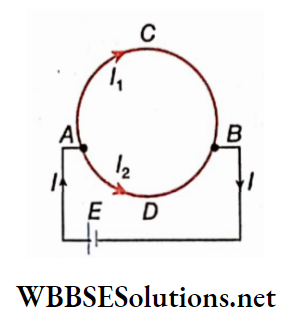
Emf of the cell (E) = 1.5V
Main current in the circuit (l) = \(\frac{1.5}{3.75}\) = 0.4 A
∴ Current through ACB (I1) = \(\frac{5}{20}\) x 0.4
= 0.1 A
Current through ADB(I2) = \(\frac{15}{20}\) x 0.4
= 0.3A

